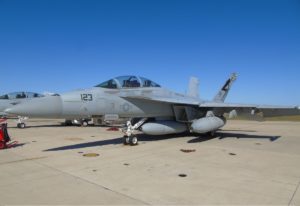The Navy’s top weapons tester warned the service’s proposed schedule for operational testing of the new F/A-18E/F Super Hornet centerline pod sensor with a fire control system does not allow much time to find and solve problems with the system before the planned start of initial testing.
The Defense Department released the latest annual report of the Director of Operational Test and Evaluation (DOT&E) on Jan. 20.

The Lockheed Martin [LMT] IRST Block II consists of a pod with a long-wave infrared sensor providing a passive fire control system to search, detect, track and engage airborne targets at long range. It acts as a complimentary sensor to the AN/APG-79 fire control radar in a heavy electronic attack or radar-denied environment, the report said.
The system’s Milestone C test and evaluation master plan was approved in May 2021, with initial operational test and evaluation (IOT&E) scheduled to begin in the second quarter of fiscal year 2024 in an effort to start full-rate production thereafter.
However, DOT&E said in for the system to be operationally effective it still needs to resolve “several deficiencies existing from previous IRST versions, as well as those noticed during Block II developmental testing (DT) of prototype systems.”
The report said that while the initial DT events had the prototype pod demonstrate tactically relevant ranges against operationally relevant targets, integration into the overall Supoer Hornet software solution “must convert long-range target detections into stable system tracks to facilitate weapons employment.”
“The ability of the Navy and the contractor to fix the critical issues on schedule is the most significant performance risk to successful IOT&E,” the report continued.
DOT&E also warned the prototype systems demonstrated reliability “well below the Navy’s requirements,” and do not include fault detection and identification. This makes troubleshooting and fault correction verification “difficult for maintainers and aircrew.”
The weapons tester recommended the Navy address the known “operating hardware and software deficiencies” of IRST Block II and Super Hornet and continue testing unproven capabilities in developmental testing. This will “prepare the system for IOT&E in order to adequately demonstrate operational effectiveness, suitability, and survivability.”
Super Hornets are produced by Boeing [BA].
The system will operate either autonomously or in combination with other sensors to support beyond-visual range air-to air missile guidance of weapons like the AIM-120 Advanced Medium-Range Air-to-Air Missile and AIM-9X Sidewinder Block II.
The IRST Block II is one of the main components in the Block III Super Hornet upgrade variant, which includes upgrades to increase the aircraft’s total flight hours and capabilities.
The new IRST pod is placed on the front of the redesigned FPU-13/A centerline fuel tank assembly on Super Hornets. DOT&E noted this lowers the fuel capacity from 480 gallons to 340 gallons, which reduces time-on-station for the Super Hornet.
The Navy and Boeing completed the first flight of a Super Hornet with an IRST BLock II pod in 2020 (Defense Daily, Jan. 16, 2020).
In 2018, the Navy awarded Boeing a $152.5 million contract to design, develop, integrate and test the IRST Block II (Defense Daily, August 20, 2018).